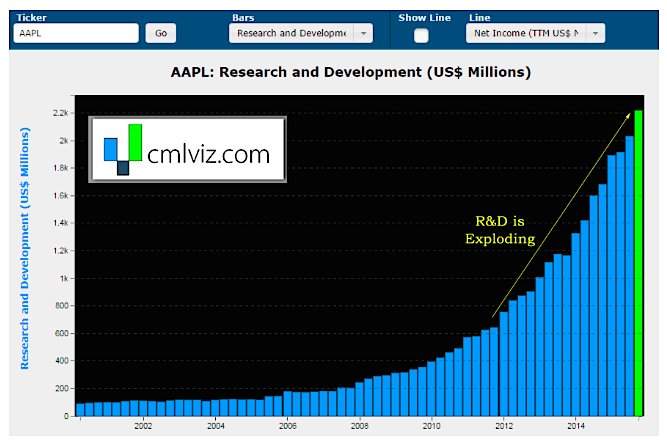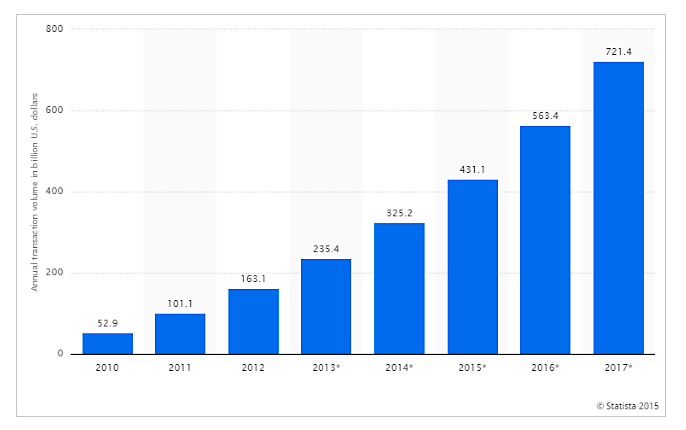News recently broke that Apple and China’s state-owned credit card processor announced plans Friday to launch Apple Pay in China. The payment system extended to Apple will allow cardholders to make payments via Apple iPhones, Apple Watches and iPads. (Source: AP).
But the real news is how the impact of Apple Pay is going to be colossal for the company.
It’s also good to note that China’s mega holiday season lines up perfectly with the release of Apple Pay.
China’s biggest shopping season comes ahead of the Lunar New Year holiday, which begins Feb. 8. – Source: AP
The Story
Apple (AAPL) is humiliating Wall Street’s analysts and the main stream media because both lack the lexicon to understand what’s actually happening in technology. While Wall Street has been calling Apple a “phone company” Apple has increased spending in research and development (R&D) by up 90% in just the last two-years.
Apple is investing in a lot of innovation and the iPhone is the hub that powers all of it. While we wrote a complete piece on Apple, for now we’ll on the Apple Pay piece. Although there has been slow adoption, it appears everything is about to change.
When a person holds their iPhone in their hands, they aren’t holding an upgraded Ericsson flip phone from 2003. They’re holding their wallets. They’re holding their keys. They’re holding their TV remote. More iPhones means more of Apple in the middle of everything we do.
Apple Pay
The largest banks are not only aware, but in bold support of the shift to mobile payment. To the extent that a mobile platform like Apple’s increases payment volumes, the banks are ecstatic. Almost every major bank in the world is now an explicit partner to Apple Pay and most have happily agreed to cut transaction costs.
“[Bank of America is] convinced of growth that measures fully 200 fold in just seven years. By the year 2022, the mobile payments growth will reach a combined total of around $3 trillion.” – Source: Investor Place
This is not a small adjunct, this is a huge, future business line that in and of itself is easily worth $100 billion in market cap. Now let’s focus on China.
Here’s a chart of global mobile payment transaction volume from Statista, forecasting out to 2017. This is in billions of dollars.
China
It’s simply a fact, the mega cap technology companies in the U.S. like Google (GOOGL), Facebook (FB), and Amazon (AMZN) can’t crack an inch into China while Apple is dominating in the region.
We know that Mobile payment transactions in China increased by 134 percent last year according to Chinese central bank data. (Source: International Business Times).
But there are a lot of Chinese technology companies trying to fight for space in the smartphone realm, and the bottom line is, Chinese consumer loyalty to Apple is just like American consumer loyalty — it knows no limits. Remember that Apple grew 99% year-over-year in China per its latest earnings report.
While analysts point other fact that Alibaba accounts for 80% of mobile pay in China, let us not forget perhaps the single most important fact, Apple hasn’t entered yet. When Apple entered the smartphone world, it accounted for 0% (zero) of smartphone profits, obviously. As of today, the iPhone accounts for 94% of worldwide smartphone profits.
And now remember this critical factor, China doesn’t celebrate Christmas like we do, China’s biggest shopping season comes ahead of the Lunar New Year holiday, which begins Feb. 8 (Source: AP).
United States
In 2015, mobile payments will total $8.7 billion in the US, with users spending an average of nearly $376 annually using their mobile phone as a payment method. By 2016, total mobile payment transactions will more than triple to $27 billion, with users spending an average of $721.47 annually (Source: eMarketer).
There are complications and rivalry is fierce. Tech firms are obsessed with the getting their payment technology in front of people to send cash to friends using an app, which is already a $7.5 billion market. It’s a money losing business, but we see PayPal and its subsidiary, Venmo, are among the most popular, though they face a growing list of competitors, including Google, Facebook, and Square. Here comes Apple.
Why Does This Matter?
Bloomberg reports:
Apple isn’t likely to find a way to profit directly from the feature. Instead, the company will probably use it to increase adoption of Apple Pay in stores.
A VP of Paypal put it this way: “We think of it as an engagement play; there’s a monetization aspect that comes second.” Richard Crone, chief executive officer at Crone Consulting said that adding the ability for owners of newer iPhone models to send each other money could double usage of Apple Pay by those customers in 18 to 24 months.
“If I send you $50, and you are not on Apple Pay P2P service, you have to enroll in it. It’s a viral application.” – Source: Bloomberg
The bottom line is as mobile pay gains traction, people won’t be using ATMs or credit cards as much. “If iPhone users start connecting Apple Pay to their bank accounts, they could bypass credit cards entirely when sending money to friends and potentially for in-store payments, cutting out middlemen” (Source: Bloomberg). And, if you want to make a bet on which company will lead the mobile revolution, I’m gonna say it’s Apple.
MONETIZATION
Although the charges in China are unknown, in the U.S. Apple gets 0.15% of all credit-card transactions and 0.5 cents per debit transaction, according to people familiar with the matter. Rickard Crone said “in three to five years, [mobile pay] could take 20 percent of credit transactions.” For the record, Visa (V) and masterCard (MA) combined have market caps above $300 billion.
And remember, mobile pay is just starting. The eventual size of the market will be enormous and the technology will be as ubiquitous as our credit cards are now. We will see a triple in the size of the market next year and future forecasts not only call for larger volumes, but larger transactions as the technology becomes second nature.
We write one story a day to uncover new opportunities and break news. Get news alerts from CMLviz once a day (it’s free).
CONCLUSION
Friends, this is a colossal business in and of itself, and it makes up just one little piece of what Apple is becoming. Never has Apple shown so much innovation, spent so much on R&D and at the same time held so much power in the consumer market. Apple Pay is going to be massive. And let’s not forget iPhone, iPhone ‘mini,’ Apple TV, Apple Watch, Apple Car, Apple Music, Mac and the next thing Apple is going to do — which we don’t even know of yet.
Research like this, until now, has been kept away from retail investors. The information asymmetry that exists between pros and non-pros has transferred massive wealth to the top 1% from the rest of us. That information asymmetry is no longer acceptable to us.
Twitter: @OphirGottlieb
The author has a current position in AAPL at the time of publication. Any opinions expressed herein are solely those of the author, and do not in any way represent the views or opinions of any other person or entity.








